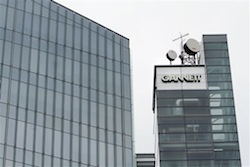By the third quarter, the revenue picture for the newspaper industry is pretty well set. Now that the Newspaper Association of America has stopped compiling quarterly results, we need to look to public company reports for a proxy. And Gannett, which owns 81 community newspapers and USA Today, is representative all by itself.
So I will hazard an informed guess that Gannett’s earnings report Monday, which showed advertising losses of 5.3 percent so far this year, indicates that the industry will again lose more than $1 billion in advertising year-to-year in 2013.
Here is the math: NAA calculated total advertising in 2012 at $22.3 billion as traditionally counted and $25.3 billion including non-dailies and other new ad related activities. A 5.3 percent decline on just the traditional portion would amount to $1.18 billion less in 2013. By comparison, 2012 was down $1.6 billion compared to 2011.
That adds up to yet another disappointing year. Total ads are falling at a slightly lower rate (5.3 percent compared to 2012’s 6.8 percent). Digital ads will be up again but not nearly enough to cover the print losses.
That’s what is known euphemistically in the industry as “sequential improvement,” a phrase Gannett CEO Gracia Martore used in yesterday’s conference call with analysts. In other words, business is still declining but not as fast as it was.
For newspapers and their newsrooms, the third quarter results and 2014 planning coincide, and the clear trend is to at least another year of making do with less.
Gannett, unannounced, did a series of staff reductions in September. Jim Hopkins, who runs the view-from-the-trenches Gannett blog, calculated that at least 434 jobs were eliminated. Other chains and papers are following suit. For instance the Virginian Pilot in Norfolk last week said it was reducing staff by 4 percent. Unpaid furloughs or salary freezes are an alternative for cost control. McClatchy CEO Pat Talamantes announced last week that there will be no raises at the company’s 30 newspapers through 2014.
These cuts are not as draconian as those of recent years, but they come at a time when there are fewer and fewer logical places to trim. The Chicago Sun-Times, for example, eliminated its professional photo staff earlier this year, choosing to rely instead on point-and-clicks from reporters and freelancers.
Gannett’s report Monday was also representative of the glass-half-full elements of the newspaper industry’s story:
- Paywalls, now installed at nearly all the community newspapers but not USA Today, are on target to generate $100 million annually in additional earnings, Martore said. However, now, as the company enters a second year of selling digital-only and bundled digital-print subscriptions, it is holding rather than growing the new revenues.
- Gannett is accepting lower print circulation volume as it aggressvely increased prices, with daily circulation off 7 percent and Sunday off 11 percent (while revenue is up modestly year-to-date). A full report from the Alliance for Audited Media on industry circulation for the period ending Sept. 30 is expected at the end of the month.
- Other digital businesses, marketing services to local merchants particularly, continue growing at a healthy pace. So Gannett’s total revenue for the first three quarters is down 1.1 percent — a considerably less alarming figure than if one looked at publishing alone. (Broadcasting revenues and profits are also down this year but will surge back with 2014 elections).
- Mobile ad revenues are modest to date, but especially at USA Today, Martore said, “we see enormous opportunity” over the next several years. The picture is similar for pre-roll video advertising, which commands much higher rates than conventional banners.
Martore also waxed enthusiastic about a change, only weeks old, of running USA Today reports on national, international, business and entertainment news as a separate section in four of its larger community papers. Together with some expansion of local reports, this amounts to as many as 70 more pages of editorial in a week, and she said that reader feedback has been overwhelmingly positive.
The Chicago Tribune has pursued the strategy of restoring content for several years now and other papers like the Dallas Morning News have followed.
It points to a paradox — one of many in the current digital + print era. Digital enthusiasts (and Warren Buffett too) say correctly that there are plenty of places to get all the national and international content you want for free. Hence, they reason, newspaper organizations should redouble concentration on local content. However it is beginning to look as if print loyalists, especially in metro markets, may prefer a generous national and international report in their local paper rather than trying to hunt the stories down digitally.
Shareholders did not react strongly one way or the other to Gannett’s report, with shares trading down about 2 percent for the day.








Comments